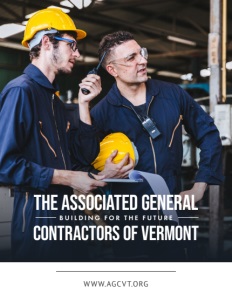The Associated General Contractors of Vermont
Building for the Future
Tackling Workforce Challenges, Housing Crises, and Industry Growth
The Associated General Contractors of Vermont (AGC/VT) is a hub for construction professionals across the state. It aims to empower contractors and support their long-term success. Through a variety of programs, the organization focuses on ensuring that construction companies in Vermont remain robust, competitive, and equipped to meet the industry’s demands.
As Vermont Regional Director of AGC/VT, Matthew Musgrave is at the heart of these efforts. “Our mission, per se, is to provide a resource to construction professionals and contractors alike that will help them succeed in their industry,” he explains. “It’s about keeping businesses healthy through a multitude of different programs and priorities.”
Musgrave describes how the organization supports its members’ success. The association doesn’t just provide surface-level support; it offers substantial resources that translate into real, measurable results. According to Musgrave, “We share various priorities with them that are not just focused on the present but also geared toward their future sustainability in Vermont.”

Addressing Vermont’s Workforce Challenge
The construction industry in Vermont is facing a daunting challenge: finding enough skilled workers to replace a rapidly retiring generation. Musgrave paints a bleak picture. “We’re seeing around 2,000 people retire every single year, but we’re only getting between 1,500 to 2,000 back,” he states. The issue goes beyond simple numbers, touching on the state’s aging population and its impact on the construction workforce.
Over the past two decades, Vermont’s demographics have shifted significantly. The population of 25- to 35-year-olds, once a robust 190,000, has now dwindled to just 90,000. Musgrave emphasizes the gravity of this change. “That cohort is essentially the garden we farm to bring people into the industry,” he explains. As the number of young people shrinks, the gap left by retiring workers grows ever wider.
Despite these challenges, Musgrave and his team are committed to finding solutions. The association has spearheaded successful job fairs, including Vermont’s most prominent career fair, which saw participation from several hundred businesses and thousands of attendees over the past two years. Yet, with the state’s unemployment rate below 2%, Musgrave acknowledges that attracting new workers remains an uphill battle. “We’re looking at creative ways to bring people in and showing pathways to be more inclusive.”
“Workforce is one of our top priorities because it’s one of the top challenges,” Musgrave stresses. Whether recruiting new workers, providing pathways to success, or keeping the current workforce safe from physical and unseen dangers, the association is finding sustainable solutions for Vermont’s construction industry.
Expanding Workforce Development Through Hands-On Training
Musgrave and the AGC/VT have taken significant steps to address Vermont’s workforce crisis by investing in workforce development programs designed to engage and train future construction professionals. The association’s training spaces are critical to this effort. “We have two 50-person training rooms and another with about 30 seats, depending on the configuration,” Musgrave notes. An ample, flexible space can accommodate up to 100 people for hands-on workshops or an auditorium.
The association has established relationships with local technical centers and high schools to introduce younger students to the trades. Musgrave explains, “We usually either go out to the schools or they bring their students here. Sometimes, it’s easier for us to go to them because they don’t have to worry about arranging transportation.” A typical training course they offer is the OSHA 10-hour certification, which covers basic safety concepts such as fall protection and chemical handling.
One of the more innovative initiatives includes partnering with schools to give students hands-on experience with heavy equipment. “We’ve had field days where members bring out several pieces of equipment, and the kids get to come out, get their hands on the controls, and move things around,” Musgrave says. These events give students a tangible sense of working in construction. For younger children, the association takes a lighter approach. “We have these yellow plastic toolboxes filled with popsicle sticks, pipe cleaners, and other materials. We hand them out to kids so they can start building small projects, like a bridge,” he explains, emphasizing the importance of introducing children to the trades early on.
Embracing Technology for Safety and Efficiency
The construction industry is undergoing a technological shift, with new tools emerging to enhance safety and streamline operations on job sites. Musgrave highlights how the AGC/VT has become a key facilitator in bringing this technology to its members. “Many of these companies come to us because we have the contractors’ attention,” he says. From there, the association collaborates with these tech providers to offer webinars and other resources, ensuring their members stay informed and up-to-date.
Musgrave explains that many member companies have already begun integrating various technologies into their daily operations. “The things that seem to resonate most with our members are apps that allow you to track where workers are on the job site,” he notes. Another popular technological advancement involves apps that store and display training records. Musgrave contrasts the new system with the old days when workers had to carry small cards proving their certification. “Now, anyone with a phone can access the platform and verify that they have the required training if OSHA shows up on site,” he explains.
Beyond construction sites, the association is also heavily involved in addressing technological changes in other industries that impact its members. Musgrave touches on the trucking sector, which has seen significant transformation. “We’re working aggressively with agencies and trucking companies to address commercial driver challenges,” he adds. These partnerships help navigate the ongoing shift in logistics and transportation, ensuring that the construction industry is equipped to meet its evolving needs.

Addressing the Stigma and Barriers in Technical Education
Musgrave highlights another critical issue: the state of Vermont’s Career and Technical Education (CTE) programs. While these programs offer valuable pathways into the trades, they face challenges hindering enrollment. “We’ve got seats available, we’ve got capacity,” Musgrave says. “But right now, there’s a financial disadvantage for a school to send students to a technical center instead of keeping them in their high school.”
The issue stems from Vermont’s centralized education funding system, allocated per pupil. Schools lose $16,000 in funding for each student they send to a technical education center. “There’s no incentive for them to send kids to CTE, so they just keep them in school, and sometimes they graduate, sometimes they don’t,” he explains. This funding structure creates a significant barrier to getting students into programs that could prepare them for trade success.
The AGC/VT is advocating for a new bill to bifurcate the funding system. Musgrave believes this change will help fill the seats in these programs without penalizing the sending schools financially. “CTE would be funded from a different bucket, so schools wouldn’t lose money when they send kids there,” he says. While traditional educators might push back, Musgrave is optimistic that the bill will pass.
Musgrave is particularly passionate about reshaping how educators perceive technical education. “We’re working to make sure every student gets introduced to these programs by at least seventh grade,” he says. This initiative includes mandatory field trips to CTE centers to expose students to the opportunities available in the trades.
However, changing attitudes toward technical education remains an uphill battle. Musgrave reflects on his own experience, noting that the stigma surrounding these programs persists. “I’m not deluded enough to think that the stigma for young men and women in CTE is going to disappear, but we can at least force the educators to shut up about it,” he says candidly. He hopes that, over time, the perception of the trades will improve, aligning more with the realities of today’s economy, where these skills are increasingly in demand.
Training and Education Initiatives
As the AGC/VT gears up for the upcoming year, Musgrave shares details of the extensive training programs on the horizon. “We’re in the peak of our training season right now,” he says, pointing out that many upcoming courses are critical for contractors and supervisors alike. “Most of the trainings are going to be OSHA 10 and OSHA 30—entry-level and supervisor safety training,” he explains. They also provide MSHA training for miners, even though Vermont doesn’t have strip mines.
Beyond the safety-focused sessions, the association also offers many other courses. “We have confined space training, fall protection training, and several soft skills courses like supervision, leadership, and blueprint reading,” Musgrave notes. He also mentions specialized training for electrical and fire alarm systems and an emerging program centered on building science and energy efficiency. “That’s something companies across the state have been asking for,” he says, emphasizing the growing demand for expertise in sustainable building practices.
Musgrave is incredibly enthusiastic about the association’s podcast studio, which has become a hub for sharing information on various topics. “Every Wednesday, we have a new podcast,” he says, encouraging members to check the schedule on the association’s website. “We’ve even got the Department of Taxes coming in because, believe it or not, sales tax can be confusing for contractors,” Musgrave remarks with a smile.
Priorities for 2024 and Beyond
Looking ahead, Musgrave’s primary focus is ensuring the AGC/VT remains relevant and continues to engage with its members. “One of the top things we want to do is ensure we’re staying relevant and engaging with people,” he says. This relevance is critical as the organization faces a significant demographic challenge, with an aging volunteer base and the need to bring fresh perspectives. “Volunteerism is one of the hardest things to come by right now,” he admits. While the organization has maintained high energy and participation, Musgrave knows this momentum must be nurtured.
The past few years have seen the association hit significant milestones. When Musgrave and Executive Vice President Richard Schwab took on leadership roles, they set out to ignite the organization’s growth. “We threw some gasoline on the fire and wanted to see this place blow up. And we did,” he recalls. Under their guidance, the association adopted new technologies, expanded its advocacy program, and rallied around transportation and capital budgets. This period of intense activity led to several national awards, including the prestigious “Chapter of the Year” honor from the Associated General Contractors of America during the height of the COVID-19 pandemic.
But the accolades didn’t stop there. In 2022, the association was again honored for its explosive membership growth, winning another national award. Musgrave proudly shares how they orchestrated an impactful election campaign, which led to further awards from the American Society of Association Executives and AGC for public relations and political engagement.
As Musgrave and Schwab prepare to fly to San Diego to collect yet another award for their overdose prevention program, Musgrave emphasizes that the key to their continued success lies in cultivating the next generation of leaders. “Our board members are starting to age out,” he says, noting that board terms are limited to ensure fresh ideas and perspectives are continually brought into the fold. He is proud to report that the association has a waitlist to join the board of directors, but he remains vigilant in keeping the momentum alive.
“Our major priority is bringing in younger people, more diverse people, and widening the net into our committees,” Musgrave says, adding that the organization’s future depends on fostering leadership among the younger members of Vermont’s construction industry. He’s pleased to see younger and more diverse representation on the board but knows the work isn’t done. “We have to continually remind our members that the success of this organization is because of them—it’s the members and volunteers who did all that work,” he stresses.
AT A GLANCE
The Associated General Contractors of Vermont
What: Information, advocacy, and training hub a hub for construction professionals across the state
Where: Vermont, USA
Website: https://www.agcvt.org/


